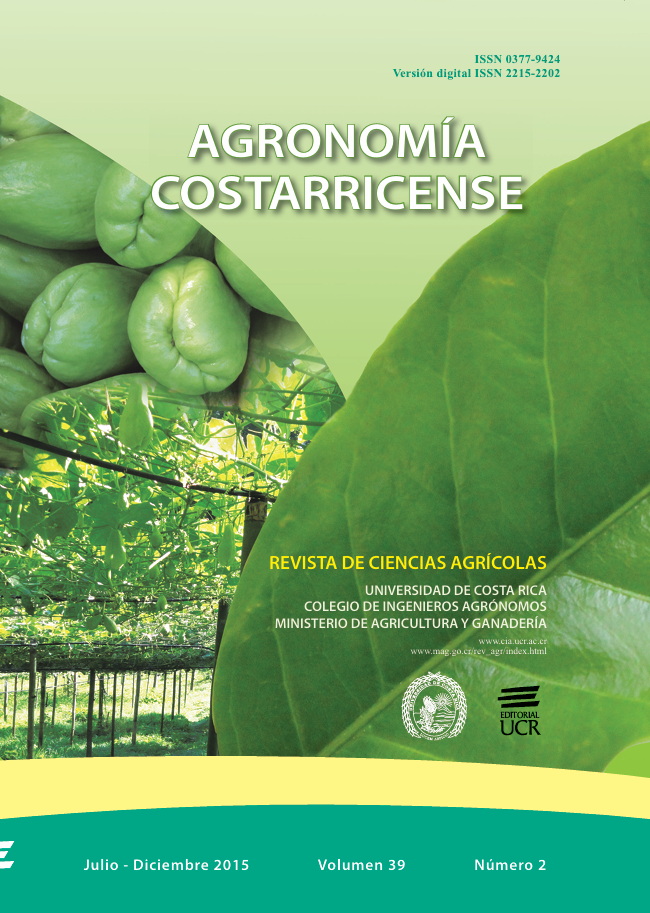Abstract
To characterize the population of producers that distribute organic vegetables in the Greater Metropolitan Area (GAM) of Costa Rica, a semi-structured survey was applied to 30 of them in different outlets from November 2013 to February 2014. They were classified into 3 groups: the first, with over 10 years’ experience and dedicated exclusively to this activity, uses family labor, plants about one hectare, and diversifies production; they are unionized and certified and have the lowest schooling, as compared to the other groups. The producers of the second group are characterized by around 7 years in the activity and almost exclusive dedication; make little use of family labor; plant less than half a hectare; are not necessarily unionized and / or certified; have an intermediate school level. The third group corresponds to producers with fewer years of experience in this activity and the lowest dedication to it; they make less use of family labor; have a smaller planting area and littlediversified crop production; may or may not be unionized and / or certified and have a higher education level. It is concluded that production of organic vegetables is a growing market, which requires external support in the form of loans and technical assistance in order to consolidate, and even compensation for environmental services produced; if these conditions are fulfilled, it will be possible to witness in coming years an important growth of the sector.References
ALTIERI M.A. 2002. Agroecología: the science of natural resource management for poor farmers in marginal environments Agriculture, Ecosystems and Environment 93:1-24.
AMADOR M. 2005. Mercado nacional de productos orgánicos. Ambientico 145:10-11.
ANONYMOUS. 2005a. The IFOAM norms for organic production and processing (version 2005). International Federation of Organic Agriculture Movements (IFOAM), Bonn. 132 p.
BAARS E., BAARS T. 2007. Towards a philosophical underpinning of the holistic concept of integrity of organisms within organic agricultura. Wageningen Journal of Life Sciences 54:463-477.
BALZARINI M.G., GONZALEZ L., TABLADA M., CASANOVES F., DI RIENZO J.A., ROBLEDO C.W. 2008. Infostat. Manual del Usuario, Editorial Brujas, Córdoba, Argentina. 336 p.
DI RIENZO J.A., CASANOVES F., BALZARINI M.G., GONZALEZ L., TABLADA M., ROBLEDO C.W. 2013. InfoStat versión 2013. Grupo InfoStat, Universidad Nacional de Córdoba, Argentina. Consultado el 20 de noviembre de 2014. Disponible en http //www.infostat.com.ar/ EL-HAGE N., HATAM C. 2003. Agricultura orgánica, ambiente y seguridad alimentaria. FAO, Roma. 259 p.
GÓMEZ R. 2012. La agricultura orgánica: los beneficios de un sistema de producción sostenible. Centro de Investigación de la Universidad del Pacífico. Perú. 70 p.
GRANADOS L., ÁLVAREZ C.J. 2006. Situación actual y desafíos de la Agricultura Orgánica en Costa Rica. In: I Congreso de Agroecología y Agricultura Ecológica Galicia, España. 24 p.
LAMPKIN N. 1994. Organic farming: sustainable agriculture in practice. In: N. Lampkin and S. Padel. The economics of organic farming. An international Perspective. Cab Internacional: United Kingdom. 468 p.
MASÍS G. 2007. Alternativas de la pequeña producción rural en el contexto actual. VECO-Costa Rica. 19 p.
MINISTERIO DE AGRICULTURA Y GANADERÍA DE COSTA RICA (MAG). 2014. Costa Rica, País tercero. Servicio Fitosanitario del Estado. Consultado el 18 de noviembre de 2014. Disponible en https://www. sfe.go.cr/perfiles/exportacion/arao/pais_tercero.html
NOVA A. 2003. La producción y el mercado de los productos orgánicos en el mundo 2000-2005. Cuba Siglo 21 34:36.
ORGANIZACIÓN DE LAS NACIONES UNIDAS PARA LA ALIMENTACIÓN Y LA AGRICULTURA (FAO) 2014. ¿Qué es la agricultura orgánica? Consultado el 18 de noviembre de 2014. Disponible en http://www.fao.org/organicag/oa-faq/oa-faq1/es/
PÉREZ A., LANG F.P., PERALTA I., AGUIRRE F.J. 2012. Percepción del consumidor y productor de orgánicos: el mercado Ocelotl de Xalapa, Ver. México Sexta Época XVI 31:20-29.
PROGRAMA NACIONAL DE AGRICULTURA ORGÁNICA (PNAO). 2013. Estudio sobre el entorno nacional de la agricultura orgánica en Costa Rica. San José, Costa Rica. 80 p.
ROSSET P.M. 1997. La crisis de la agricultura convencional, la sustitución de insumos y el enfoque agroecológico. In Agroecología y Desarrollo. Revista de
CLADES11/12:2-12. RUBIO L.M. 2006. Caracterización empresarial de algunos productores de hortalizas orgánicas en la Sabana de Bogotá y alrededores. Cuadernos de Desarrollo Rural 57(3):133-162.
SOTO C. 2003. Mercado local para nuestra producción orgánica. Ambientico 122:9-10.
STOCKDALE E., LAMPKIN N., HOVI M., KEATINGE R., LENNARTSSON E., MACDONALD D., PADEL S., TATTERSALL F., WOLFE M., WATSON C. 2001. Agronomic and environmental implications of organic farming systems. Advances in Agronomy 70:263-327.
WILLER H., LERNOUD J. 2014. The World Organic Agriculture. Statistics and Emerging Trend (FiBLIFOAM Report). Research Institute of Organic Agriculture ((FiBL), Frick, and International Federation of Organic Agriculture Movements (IFOAM), Bonn. Swiss. 308 p.

